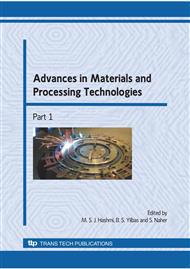p.1165
p.1173
p.1182
p.1190
p.1197
p.1205
p.1212
p.1220
p.1228
The Influence of Welding Parameters on Tensile Behavior of Friction Stir Welded Al 2024-T4 Joints
Abstract:
In the present study, the relationships between friction stir welding parameters and the tensile behavior of Al 2024-T4 joints was investigated. The aluminum alloy plates were butt-welded using a hardened steel tool with a threaded and fluted cylindrical pin at various tool rotation speed to advancing speed ratios. Metallographic observations, EDS analysis and microhardness measurements show that the band spacing in the periodic microstructure of the stir zone and the average microhardness of this region decrease with increasing speed ratio. Tensile ductility is strongly affected by welding parameters and final elongation increases significantly with speed ratio at the constant rotating speed of 900 rpm. This behavior is found to be associated with a change in tensile fracture location. Formation of microscopic voids at low speed ratios leads to premature fracture in the nugget zone, while in the defect-free joints produced at higher speed ratios the fracture location shifts into the HAZ on the retreating side, which exhibits the lowest microhardness value within the weld joint. At the optimum rotation speed of 900 rpm and speed ratio of 11.2 rev/mm the tensile strength and final elongation of the joints are equivalent to 97% and 77% that of base metal, respectively.
Info:
Periodical:
Pages:
1197-1204
Citation:
Online since:
December 2009
Authors:
Price:
Сopyright:
© 2010 Trans Tech Publications Ltd. All Rights Reserved
Share:
Citation:


